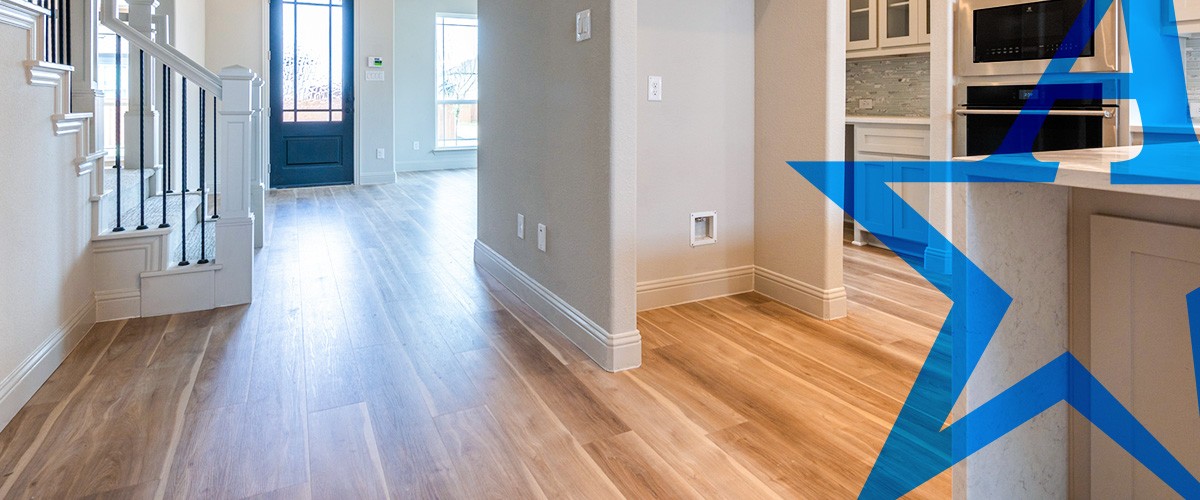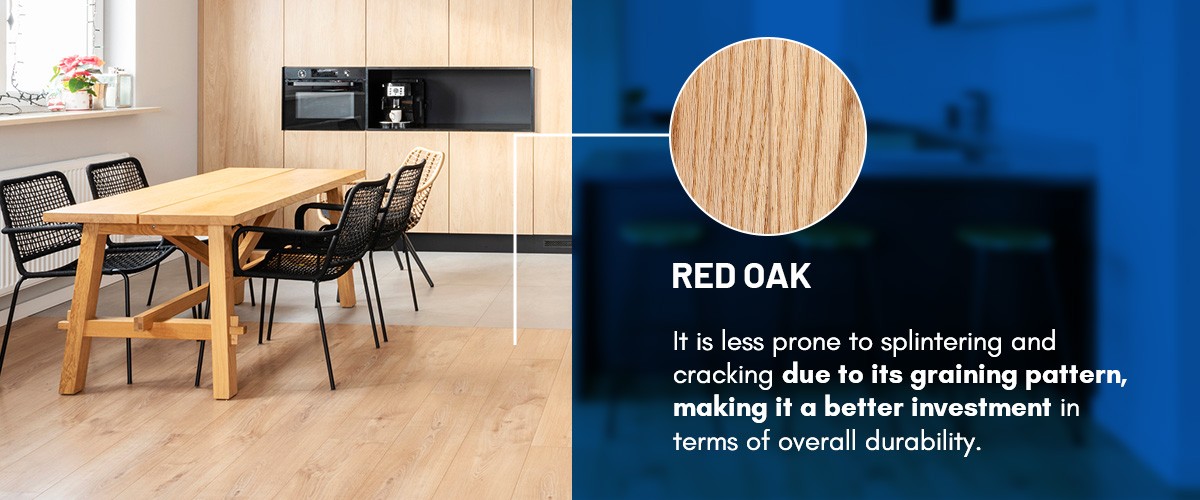Red Oak Hardwood Flooring Benefits

Hardwood floors are a sure-fire way to add elegance and value to your home. These floors work well with most interior styles and aesthetics and are available in various natural wood species. The abundance of choice might actually leave you wondering which type of hardwood flooring is best for your home.
We’ve rounded up everything you need to know about red oak hardwood flooring to help you make an informed decision.
The Unmatched Benefits of Red Oak Hardwood Flooring
Red oak is a hardwood tree native to North America that thrives in deciduous forests in the Northern United States. It is highly abundant, making it the flooring of choice for many homeowners and contractors.
Durability and Stability
Red oak wood has a Janka hardness rating of 1290. The Janka hardness rating system measures the wood’s surface, how easy it is to cut and the force required to drive a 0.444-inch steel ball through the wood up to half its diameter. Based on these ratings, the flooring industry often compares red oak vs. white oak, as the latter also holds an impressive Janka rating.
The primary difference between these two oak species is their hue. Oddly, white oak boasts a darker color, with beige and brown shades, while red oak offers more salmon and pink undertones. Both red and white oak are similar in price, with red oak typically carrying a slightly lower price tag.
White oak is a worthwhile option, though it’s not as abundantly available as red oak. White oak has a smoother, more subtle and tighter grain. With a Janka hardness rating of 1360, it is slightly less prone to denting.

While both hardwood floors are timelessly elegant, red oak has a more dramatic grain. It is less prone to splintering and cracking due to its graining pattern, making it a better investment in terms of overall durability.
Aesthetic Appeal
Red oak hues range from light cream to reddish pink and brown. The warm undertones of this wood can bring warmth to a room. This wood also has a wavy and elaborate open-grain texture, and the larger pores make it easy to customize the stain. Whether you’d prefer a lighter hue or a richer red tone, red oak absorbs stain deeply and evenly.
The strong grain properties of red oak also make it fairly resistant to scratches. Even when scratches start to show after years of wear and tear, you can refinish them. Refinishing a red oak hardwood floor is easier than refinishing hardwood species with a higher Janka rating because softer wood is easier to work with.
Cost-Effectiveness and Value
Due to its abundance, red oak is more readily available. As a result, the cost of red oak hardwood is reasonable compared to other hardwood species.
Many factors determine the eventual cost of hardwood floors, and prices change to account for shifts in supply and demand. Still, red oak hardwood flooring is a cost-effective option. The average price ranges between $5 and $9 per square foot.
Maintenance Tips for Longevity
This softer wood is easier to work with, so sizing and fitting the boards together is slightly easier than other hardwood species.
When it comes to maintenance, avoid harsh chemical cleaners and stick with soft, microfiber mops and gentle cleaning solutions designed for hardwood floors. It’s best to wipe up spills and messes quickly to prevent stains and water marks from forming.
Beyond everyday cleaning, you’ll want to have red oak refinished every 10 or so years. Refinishing smooths the surface and polishes out imperfections. A new finishing coat and sealant are also applied to restore the hardwood. When you take good care of red oak flooring, it can last decades.
Additional Considerations for Choosing Red Oak
Beyond aesthetics, costs and maintenance, hardwood floors have much more to offer homeowners.
Eco-Friendliness and Property Value
Most species of hardwood are considered eco-friendly. Hardwood flooring is sourced responsibly, and there’s no chance of it ending up in landfills because wood is recyclable. The overall impact on the environment is minimal between sourcing and manufacturing.
Hardwood floors are also a worthwhile investment to boost property value. Because this flooring offers incredible longevity, it’s a long-term investment. Even though it may come with higher initial costs, the overall durability and low maintenance requirements ensure long-term cost-efficiency. Unlike carpeting, laminate and other types of flooring, red oak hardwood floors don’t require routine replacement every few years.
Engineered vs. Solid Red Oak Flooring
You can find both engineered and solid red oak hardwood flooring. Solid wood can withstand sanding and refinishing, while engineered wood has limited sandability. Engineered wood has a life span of about three decades, while solid wood can last up to a century. Even though engineered wood is more affordable, it won’t last as long as solid red oak.
Why Choose Red Oak?
Red oak is a durable hardwood species that can last decades. The beautiful, dramatic open-grain pattern offers timeless elegance and is slightly more affordable than white oak, although investing in any hardwood species offers homeowners a high return.
The type of flooring you choose depends on your budget, personal style, the room you are installing and other factors. Red oak hardwood flooring is the way to go for a traditional look and an affordable and durable choice.
Shop Red Oak Flooring at All American Flooring
All American Flooring has over three decades of experience providing flooring for homeowners around Dallas-Fort Worth. We are dedicated to providing our customers with superior quality and unbeatable prices. Our unmatched warranty program guarantees quality, from flooring products to installation services.
Use our room visualizer tool to get a realistic idea of how new hardwood floors will look in every room of your home. Simply upload photos of your room and select different flooring products!
Schedule a complimentary in-home estimate or purchase your new flooring online.



